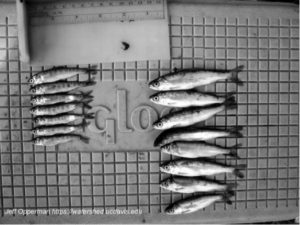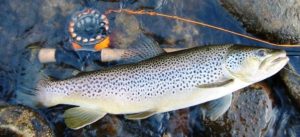by Michael K. Homza, PE
It’s humbling to stand on the banks of the Boise River as it roars by above its official flood discharge of  7,200 cubic-feet-per-second (cfs). It’s deep, cold and fast. I wonder if I could survive an attempt to
7,200 cubic-feet-per-second (cfs). It’s deep, cold and fast. I wonder if I could survive an attempt to
swim across to the other bank. I shudder at the thought. Luckily, I don’t have to be in the river; but what about the fish? How do they survive this roiling rollercoaster? Aren’t they just swept away during high flows? Where do they go in high water? The short answer is simple: floodplains.
As Tamsen Binggeli mentioned in her March 6, 2017 blog, floodplains provide many benefits including flood moderation, water quality improvement, recreation and habitat diversity. (Reference 1) For this discussion, floodplains include smaller side channels, sloughs, wetlands, beaver ponds and other areas of inundation beyond the river’s main channel.
Floodplain Diversity Supports A Healthy Fishery
Fish typically escape a river’s fast flood flows in floodplains. They usually spread out and find refuge in slower moving water as the river spreads out. (Reference 2) This preserves a fish’s metabolic energy and promotes fish growth. Juvenile fish also use floodplains as nurseries as they develop and grow.
Generally speaking, the quality of a floodplain’s habitat is directly proportional to its diversity. This is because different fish species, life stages and food sources utilize different types of habitat. Diversity in aquatic and riparian habitat supports species diversity and health. Variations in water depth, water velocity, substrate composition, in-stream wood and rock formations and streamside vegetative cover all play important roles in habitat diversity and quality.
Water temperature is also an important factor with respect to floodplain suitability because fish are cold blooded. As cold floodwater enters a floodplain from the river, it spreads out, slows down, deposits sediment and warms slightly. Phytoplankton and algae – fast-growing aquatic plant life – grow as this occurs. Populations of zooplankton and other aquatic invertebrates, including insects – which comprise the main food source for juvenile fish – feed on this aquatic plant life. If water is too cold, juvenile fish are lethargic and growth is slow. If the water is too warm it causes increased metabolic demands and reduced dissolved oxygen, inhibiting growth and increasing mortality. (Reference 3)
Floodplain Habitat Beneficial for Fish Growth
A 2008 study out by the University of California, Davis (Reference 3) underscores just how important floodplains are in the development of Salmonids. (Fish belonging to the taxonomic family of Salmonidae, which includes salmon, trout, char and whitefish.) In this study, juvenile Chinook salmon were placed in two different types of enclosures when the wild salmon would naturally be rearing in  floodplain habitats in and along the Cosumnes River in California. One group of enclosure represented the open, faster water associated with the river, whereas the second group of enclosure was placed on the river’s inundated floodplain. Overall, the study concluded that the juvenile fish realized higher growth rates and lower mortality in the floodplain habitat when compared to those in the river habitat. The photo shows the juvenile salmon from these two study groups; the larger ones being the fish reared in the floodplain enclosure.
floodplain habitats in and along the Cosumnes River in California. One group of enclosure represented the open, faster water associated with the river, whereas the second group of enclosure was placed on the river’s inundated floodplain. Overall, the study concluded that the juvenile fish realized higher growth rates and lower mortality in the floodplain habitat when compared to those in the river habitat. The photo shows the juvenile salmon from these two study groups; the larger ones being the fish reared in the floodplain enclosure.
Preserve and Protect the Boise River Floodplain
Of course, a healthy, diverse floodplain must exist to support a healthy fishery. The floodplain must also be hydraulically connected to the river and not cut off by levees, roads, culverts and other barriers. Currently, the Boise River possesses these attributes only marginally as its tributaries, side channels, wetlands and other floodplain features have been sacrificed to land development over time.

As development continues along the Boise River corridor, we must employ measures that protect, preserve and enhance the river’s floodplains to maintain the river’s native fishery and all the other benefits the river and its floodplains provide. BREN’s Boise River Enhancement Plan recommends removing or setting back confining elements like levees and re-establishing or creating side channel habitat to improve aquatic habitat. And for your safety – take a lesson from the fish – stay out of the river’s fast flowing flood water!
Mike Homza is a long-time resident of Boise; President of Stream Line Design, LLC; Vice Chair of BREN and focuses his career on a enhancing rivers, stream and their floodplains.